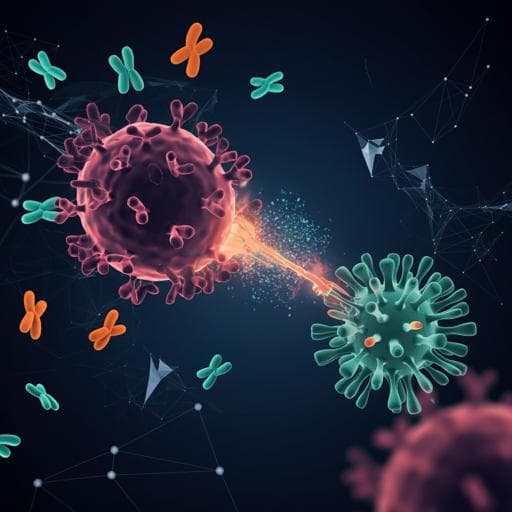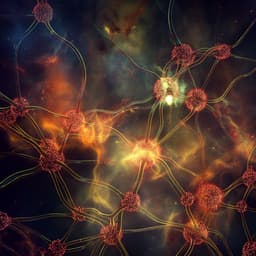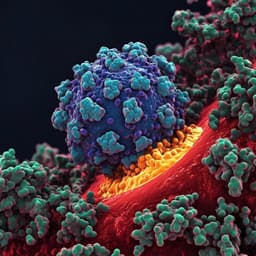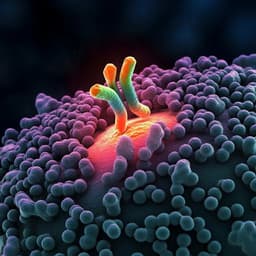
Medicine and Health
SARS-CoV-2 specific antibody and neutralization assays reveal the wide range of the humoral immune response to virus
M. Dogan, L. Kozhaya, et al.
This groundbreaking study developed highly sensitive SARS-CoV-2-specific antibody and neutralization assays, revealing significant findings about antibody responses in COVID-19 patients. Conducted by a team of researchers that includes Mikail Dogan, Lina Kozhaya, and Derya Unutmaz, this research could enhance our understanding of vaccine effectiveness.
~3 min • Beginner • English
Introduction
SARS-CoV-2 enters host cells via its spike protein binding to ACE2 and priming by TMPRSS2. Antibodies targeting spike can neutralize viral entry and are considered central to protective immunity. Accurately quantifying the magnitude, isotype composition, and neutralizing capacity of antibodies over the course of COVID-19 and convalescence is essential for predicting protection and informing convalescent plasma therapy and vaccine development. Existing serologic assays often lack dynamic range and sensitivity and can be confounded by cross-reactivity to endemic coronaviruses. Live-virus neutralization requires BSL-3 containment, limiting throughput. The study aimed to develop highly sensitive bead-based immunoassays for SARS-CoV-2-specific antibodies and robust spike-pseudotyped lentiviral neutralization assays, and to relate antibody/neutralization levels to disease severity and subject characteristics.
Literature Review
The authors note that many available SARS-CoV-2 serologic tests lack sufficient dynamic range and sensitivity and may be affected by cross-reactivity with endemic coronaviruses. Neutralizing antibodies are key correlates of protection and have been identified in prior studies. Conventional neutralization assays often require live virus and BSL-3 facilities, underscoring the need for sensitive, scalable alternatives.
Methodology
Study population: 115 PCR-confirmed COVID-19 subjects (69 female, 46 male) were recruited at SUNY Downstate Medical Center (NY), Cedars-Sinai (Los Angeles), and University of Connecticut School of Medicine (Farmington). Convalescent plasma donors were recruited at Cedars-Sinai under FDA guidelines; 56 de-identified healthy controls or PCR-negative controls were included. Plasma was aliquoted, stored at −80°C, and heat-inactivated (56°C, 30 min) prior to assays. Ethics approvals were obtained (IRB numbers provided). Subject demographics and timing between PCR and blood draw are summarized in Table 1.
Bead-based flow immunoassay: Streptavidin-coated DevScreen SAv magnetic beads were conjugated with biotinylated SARS-CoV-2 antigens: Spike RBD, Nucleocapsid, S1, S1-NTD, and S2-ECD. Conjugation was verified by anti-His staining and flow cytometry. Beads were incubated with plasma (starting 1:100, with three additional tenfold serial dilutions) or controls (anti-S-RBD IgG; soluble ACE2-Fc). Detection used PE-conjugated secondary antibodies to human IgG, IgM, IgA, and IgG1–4 subclasses. Flow cytometry (iQue Screener Plus) measured PE median fluorescence; titration curves were generated and area under the curve (AUC) values normalized using 20 healthy controls; thresholds were mean control AUC + 1 SD. Selected samples were also tested by commercial ELISA for comparison.
Spike expression and pseudovirus production: Human codon-optimized SARS-CoV-2 spike constructs, full-length and C-terminally truncated lacking the ER retention signal (last 19 aa), were cloned into an expression vector (pLP/VSVG backbone) under a CMV promoter. HEK-293T cells were transfected (Lipofectamine 3000) and spike surface expression verified by staining with soluble ACE2-Fc and anti-Fc antibody via flow cytometry.
SARS-CoV-2 and SARS-CoV spike pseudotyped lentiviruses were generated by co-transfecting HEK-293T cells with lentivector plasmids encoding GFP or RFP reporters and plasmids encoding SARS-CoV-2 spike or SARS-CoV spike. Supernatants were harvested 24–48 h post-transfection, filtered (0.45 μm), concentrated (Lenti-X), aliquoted, and stored at −80°C. Infectious titers were quantified by infecting ACE2-overexpressing 293 cells and measuring reporter-positive cells by flow cytometry at 72 h.
ACE2-overexpressing target cells: Human ACE2 was codon-optimized and cloned as ACE2-IRES-GFP or an ACE2-mKO2 fusion. Lentiviral transduction of HEK-293T generated stable 293-ACE2 cells. ACE2 expression was confirmed by staining with SARS-CoV-2 S1-mouse Fc and anti-mouse Fc.
Neutralization assays: Threefold serial dilutions of monoclonal antibodies (four S-RBD NAbs and one non-neutralizing S-RBD antibody), recombinant soluble ACE2 (two sources), or serially diluted plasma (from 1:10 to 1:10,000) were preincubated with SARS-CoV-2 RFP or SARS-CoV GFP pseudoviruses (MOI 0.2) for 1 h at 37°C, then added to 293-ACE2 cells. After 72 h, infection was quantified by reporter expression via flow cytometry. Percent infection was normalized to no-inhibitor controls. Half-maximal inhibitory concentrations (IC50 for reagents) and 50% neutralization titers (NT50 for plasma) were calculated using 4-parameter nonlinear regression (GraphPad Prism).
Statistics: Group comparisons used two-tailed Mann–Whitney U tests. Correlations used two-tailed Spearman’s rank. P<0.05 was considered significant. No formal adjustments for multiple comparisons were made; all pairwise tests are reported.
Key Findings
- Assay performance and dynamic range: Anti–S-RBD and anti–Nucleocapsid IgG were detected across a ~3-log AUC range (~10^4 to ~10^7). S-RBD–specific IgM (40/40) and IgA (115/115) were detectable above thresholds in all subjects tested. Sensitivity/specificity: S-RBD IgG 100%/99.34%; S-RBD IgM 100%/90.9%; S-RBD IgA 94.26%/87.87%; Nucleocapsid IgG 99.13%/94.93%. The bead-based assay correlated strongly with ELISA (r=0.8619) and showed wider dynamic range.
- Antigen capture: S-RBD captured significantly more antibodies than S1 (p=0.0356). IgG1 levels were comparable to total IgG; other IgG subclasses were lower.
- Severity associations: S-RBD and Nucleocapsid IgG and S-RBD IgA levels were significantly higher in hospitalized and ICU/deceased patients than outpatients and convalescent plasma donors. No sex differences were observed within severity groups.
- Neutralization: No neutralization was seen in healthy controls (n=34), whereas COVID-19 plasma neutralized SARS-CoV-2 pseudovirus up to 1:10,000 dilution. NT50 values were significantly higher in hospitalized and ICU/deceased patients than outpatients and up to ~1000-fold higher than convalescent plasma donors. No sex differences in NT50 within groups.
- Cross-neutralization: Most COVID-19 plasmas also neutralized SARS-CoV pseudovirus, albeit less efficiently than SARS-CoV-2. NT50 values for SARS-CoV-2 and SARS-CoV correlated in hospitalized subjects (rs=0.3766, p=0.0099), but not in outpatients or donors. Soluble ACE2 neutralized both pseudoviruses dose-dependently; S-RBD NAbs neutralized SARS-CoV-2 much more potently than sACE2 and did not neutralize SARS-CoV.
- Correlations with neutralization: NT50 correlated with antibody levels: S-RBD IgG r=0.81; Nucleocapsid IgG r=0.689; S-RBD IgA r=0.60; S-RBD IgM r=0.47. S-RBD IgG subclass correlations with NT50: IgG1 r=0.80; IgG3 r=0.69; IgG2 r=0.67; IgG4 r=0.51. Total S-RBD IgG correlated strongly with IgG1 (r=0.96).
- Age associations: Increasing age correlated with higher S-RBD IgG (r=0.53), Nucleocapsid IgG (r=0.43), S-RBD IgA (r=0.41), and NT50 (r=0.579).
- Antibody durability over study window: Excluding samples ≤15 days from PCR, no correlation was observed between days since PCR and S-RBD IgG or NT50, suggesting persistence over approximately 3 months in this cohort.
- From the abstract: hospitalized patients had up to 3000-fold higher antibody and neutralization titers than outpatients or convalescent plasma donors.
Discussion
The study demonstrates that highly sensitive bead-based serology coupled with spike-pseudotyped lentiviral neutralization provides robust, scalable measures of SARS-CoV-2 humoral immunity. The strong correlations between S-RBD–specific antibodies (particularly IgG and IgG1) and NT50 indicate that RBD-directed responses are major contributors to neutralization and that quantitative S-RBD serology could serve as a practical proxy for neutralizing activity in clinical settings. Antibody magnitude and neutralization capacity stratified by disease severity, with hospitalized and ICU/deceased patients exhibiting substantially higher titers than outpatients and convalescent plasma donors. These findings inform donor selection for convalescent plasma therapy by highlighting the need to identify donors with high NT50 titers. Cross-neutralization of SARS-CoV by many COVID-19 plasmas suggests antibodies targeting conserved spike epitopes; correlation between SARS-CoV-2 and SARS-CoV NT50 in hospitalized subjects supports cross-reactive neutralizing responses in more severe disease. The assays also discriminated differences among monoclonal NAbs and soluble ACE2 reagents, supporting their utility for screening therapeutic antibodies and entry inhibitors. Overall, the results address the central question of how to sensitively quantify and interpret the breadth and potency of the humoral response to SARS-CoV-2 across clinical spectra, with implications for evaluating immunity and vaccine responses.
Conclusion
This work introduces sensitive, high-dynamic-range bead-based immunoassays for SARS-CoV-2 antibodies and robust spike-pseudotyped lentiviral neutralization assays. All PCR-confirmed subjects had detectable antibodies and nearly all had neutralizing activity, absent in controls. Antibody and neutralization titers varied widely and were strongly associated with disease severity, with hospitalized patients showing much higher levels than outpatients and convalescent plasma donors. S-RBD–specific antibodies, particularly IgG/IgG1, correlated strongly with neutralization, supporting their use as surrogate markers. Cross-neutralization of SARS-CoV was common, indicating targeting of conserved spike epitopes. These tools can be applied to monitor antibody dynamics over time, assess vaccine-induced responses, guide selection of high-titer convalescent plasma donors, and screen therapeutic antibodies or entry inhibitors. Future studies should extend longitudinal follow-up to define durability of neutralization, evaluate responses to emerging variants, and refine thresholds of antibody/NT50 that correlate with protection.
Limitations
- No formal adjustment for multiple comparisons was performed, which may increase the chance of type I error across numerous pairwise tests.
- Durability conclusions are limited to approximately a 3-month observation window in this cohort; longer-term persistence was not assessed.
- Neutralization assays used pseudotyped lentiviruses rather than live virus; while validated and safer, results may not fully recapitulate all aspects of live-virus entry and neutralization.
Related Publications
Explore these studies to deepen your understanding of the subject.







